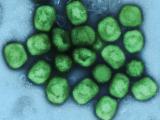Apr 25, 2006 (CIDRAP News) Scientists have come up with a new approach to neutralizing the toxin produced by anthrax bacteria and have tested it successfully in a small number of animals, according to a report published this week.
The researchers created a fatty bubble, studded with proteins, that binds to a key component of anthrax toxin at multiple sites, preventing it from attaching to host cells, the National Institutes of Health (NIH) said in a news release.
"This novel approach to the design of anthrax antitoxin is an important advance, not only for the value it may have in anthrax treatment, but also because this technique could be used to design better therapies for cholera and other diseases," said NIH Director Elias A. Zerhouni, MD.
The NIH-supported research was done by a team led by Ravi S. Kane, PhD, of Rensselaer Polytechnic Institute in Troy, N.Y., and Jeremy Mogridge, PhD, of the University of Toronto. Their report was published Apr 23 in Nature Biotechnology.
As explained in the NIH release, the toxin produced by Bacillus anthracis has three parts: a protein called protective antigen (PA), which binds to receptors on target cell surfaces, and two enzymes. When PA binds to a host cell, it creates a pore that enables the enzymes to enter the cell.
The PA molecule has a number of sites that can bind to host cells, the NIH said. Therefore, Kane and colleagues created a molecule that can cling to PA at multiple sites. The protein-studded bubble they produced is called a peptide-functionalized liposome.
"Just as a glove matches the shape of a hand more closely than a mitten, and so fits more snugly, the polyvalent inhibitor binds the toxin at multiple sites and is orders of magnitude more potent than an inhibitor that binds at a single site," the agency said. "The multiple peptides on the functionalized liposome are arranged with the same average spacing as the binding sites of the PA molecule, which permits a firmer bond between the two, explains Dr Kane."
In test-tube experiments, the antitoxin was 10,000 times more potent than single peptides, the NIH said.
The antitoxin was also tested in rats. When nine rats were simultaneously injected with anthrax toxin and relatively small doses of the new antitoxin, five of them remained healthy. When slightly higher doses of the inhibitor were used, eight of nine rats were protected. The journal article says the experiment was the first to show that a liposome-based polyvalent inhibitor works in animals.
The investigators used the same liposome-based technique to develop a polyvalent inhibitor of cholera toxin, which also worked well in test-tube experiments, the NIH said.
The team next plans to infect animals with B anthracis and allow the disease process to begin before treating them with the anthrax antitoxin, the agency said.
Rai P, Padala C, Poon V, et al. Statistical pattern matching facilitates the design of polyvalent inhibitors of anthrax and cholera toxins. Nature Biotech 2006 Apr 23 (early online publication) [Full text]
See also:
Apr 24 NIH news release
http://www.niaid.nih.gov/news/newsreleases/2006/Pages/AMD_06.aspx




















